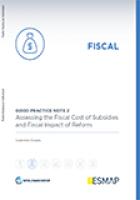Publications
The objective of this good practice note is to outline the ingredients of an assessment of the fiscal impacts of energy subsidies in an economy from the aggregate fiscal perspective of the government. It demonstrates the interrelations between the fiscal balance, its financing, and impact on key debt and fiscal sustainability indicators. As discussed in the Energy Sector Reform Assessment Framework (ESRAF) Good Practice Note on the definition of energy subsidies (Note 1), energy subsidies may be provided through various channels on the production and consumption sides, and may generate contingent liabilities—explicit or implicit—for a government that must be monitored and managed as part of overall macroeconomic management. ESRAF defines an energy subsidy as a deliberate policy action by the government that specifically targets electricity, fuels, or district heating and that reduces the net cost of energy purchased, reduces the cost of energy production or delivery, increases the revenues retained by energy suppliers, or has any combination of these three effects. ESRAF also covers non-energy use of oil, gas, and coal, such as natural gas used as a feed stock for fertilizer manufacture and naphtha and liquefied petroleum gas (LPG) used as feed stocks in petrochemicals. Subsidies are not always paid for by the government. Consumers may subsidize producers, producers may subsidize consumers, and financiers and other actors not linked to energy consumption or production, including those outside the country, may be covering the costs of subsidies.
This note focuses on the costs of subsidies to the government. One important form of subsidies consists of direct budgetary transfers from the government to either consumers or producers, which are recorded in the government public sector budget. For instance, with the justification of social benefits, governments often establish consumer prices for energy that are below reference prices (prices that would have prevailed in a competitive market, or the cost of efficient production if a competitive market does not exist), and then compensate the energy suppliers for the difference (also referred to as the price gap) between the reference prices and the government controlled prices. Another subsidy delivery mechanism is provision of the subsidy benefits directly to end users, typically households. In addition, a government may provide subsidies in the form of tax exemptions to energy service providers, tax credits for investment, or allowing the energy-related public utilities and national oil companies to run arrears on their debt service and other payment obligations to the government.
ESRAF Good Practice Overview: Guidance for Comprehensive Energy Subsidy Reforms
ESRAF Good Practice Note 1: Identifying and Quantifying Energy Subsidies
ESRAF Good Practice Note 2: Assessing the Fiscal Cost of Subsidies and Fiscal Impact of Reform
ESRAF Good Practice Note 6 to come: Identifying the Impacts of Higher Energy Prices on Firms and Industrial Competitiveness
ESRAF Good Practice Note 7: Modeling Macroeconomic Impacts and Global Externalities
ESRAF Good Practice Note 10: Designing Communication Campaigns for Energy Subsidy Reform
Gooptu, Sudarshan. 2018. Assessing the Fiscal Cost of Subsidies and Fiscal Impact of Reform: Energy Subsidy Reform Assessment Framework (ESRAF) Good Practice Note 2. ESMAP Paper. Washington, D.C.: World Bank Group. http://documents.worldbank.org/curated/en/958771530881102150/pdf/ESRAF-note-2-Assessing-the-Fiscal-Cost-of-Subsidies-and-Fiscal-Impact-of-Reform.pdf
